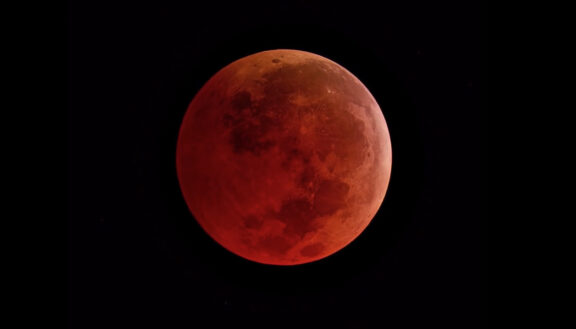Lunar eclipses
What is a lunar eclipse?
A lunar eclipse happens when the Moon and Earth line up so that the Earth’s shadow falls over the Moon and darkens it. Conversely, a solar eclipse happens when the Moon and Sun line up so that the Moon’s shadow falls on the Earth.
What is a total lunar eclipse?
During a total lunar eclipse the Moon is completely covered by the darkest portion of Earth’s shadow, known as the umbra. This is different from a partial lunar eclipse, during which the Moon does not entirely cross through the umbra.

What is a blood moon?
During a total lunar eclipse, the darkest portion of Earth’s shadow completely covers the Moon. You might assume that the Moon would be dark during this time but that’s not the case. Some sunlight still reaches the Moon’s surface after bouncing through the edges of Earth’s atmosphere.
Our atmosphere scatters blue light, which is why the sky looks blue during the day. At sunrise and sunset when the Sun is low on the horizon, the sunlight reaching you has passed through even more atmosphere. This scatters away most of the blue light, creating red-tinged skies and beautiful sunsets.
The same thing happens during a lunar eclipse. Although the Moon is in shadow, the edges of Earth’s atmosphere still scatter some red light onto the Moon’s surface. The actual term blood Moon dates back to at least biblical times and has been tied to the apocalypse. But there’s no need to panic — a red-tinged Moon is simply the result of an infinite cosmic ballet.

What is a supermoon?
A supermoon happens when the full Moon falls near the point where the Moon is closest in its orbit to Earth. This happens roughly once a year, and when it does a supermoon usually recurs for a couple full Moons in a row.
The Moon’s 27-day orbit around the Earth is not perfectly circular. Its distance to Earth varies between 363,300 and 405,500 kilometers (226,000 and 253,000 miles). When the Moon is at its closest point to Earth, it appears up to 14 percent bigger and 30 percent brighter to observers on Earth.

Why does the Moon look bigger sometimes?
Sometimes when you see a full or nearly full Moon low on the horizon, it looks extra large, regardless of whether or not it is near the closest point in its orbit to Earth. This is a trick of the brain called the Moon illusion — in reality the Moon’s size doesn’t change as it travels across the sky.
Scientists aren’t sure exactly what causes the Moon illusion, but one common explanation is that you’re used to seeing the Moon high in the sky all by itself. When you happen to see it low on the horizon next to familiar foreground shapes like trees and buildings, your brain perceives it as being larger than normal.
Why don’t we have a lunar or solar eclipse every month?
The Moon’s orbit around the Earth is tilted by about 5 degrees. The orbit wobbles like a hula hoop spinning around a person’s waist, ensuring that the Moon doesn’t line up perfectly with the Earth and Sun on every 27-day orbit.
On average, we get two lunar eclipses and between two and five solar eclipses each year.
The Moon's orbital tilt Because the Moon's orbit around the Earth is tilted by about 5 degrees, the Moon does not fall within Earth's shadow every month to create a lunar eclipse. This NASA visualization shows the Moon missing Earth's shadow for several months before finally passing through it, creating a lunar eclipse. Credit: NASA's Scientific Visualization StudioVideo: NASA's Scientific Visualization Studio


 Explore Worlds
Explore Worlds Find Life
Find Life Defend Earth
Defend Earth

